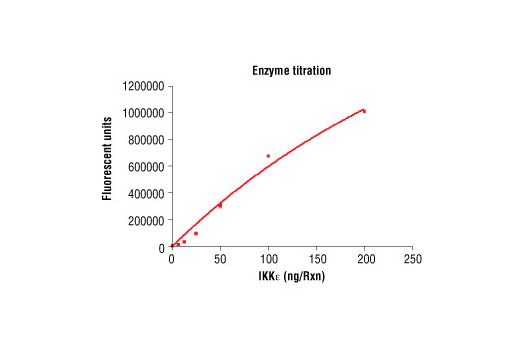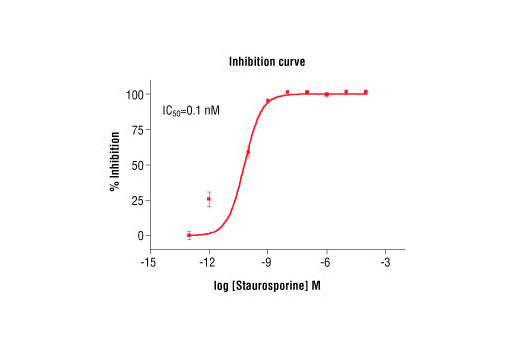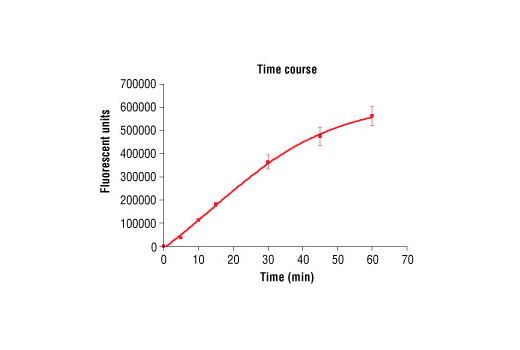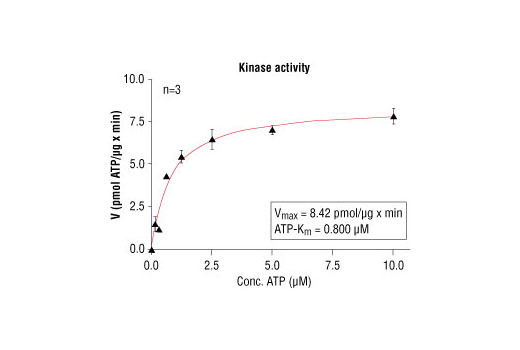#Q14164
9641
Product Information
Storage
Keep enzymes on ice during use.
Avoid repeated freeze-thaw cycles.
Source / Purification
The GST-Kinase fusion protein was produced using a baculovirus expression system with a construct expressing full-length human IKKepsilon (Met1-Val716) (GenBank Accession No. NM_014002) with an amino-terminal GST tag. The protein was purified by one-step affinity chromatography using glutathione-agarose.
Product Description
| Molecular Formula | Peptide substrate, Biotin-PAK1 (Ser144)/PAK2 (Ser141) peptide: 1,775 Daltons. GST-IKKe Kinase: 110 kDa. |
Background
The NF-κB/Rel transcription factors are present in the cytosol in an inactive state, complexed with the inhibitory IκB proteins (1-3). Most agents that activate NF-κB do so through a common pathway based on phosphorylation-induced, proteasome-mediated degradation of IκB (3-7). The key regulatory step in this pathway involves activation of a high molecular weight IκB kinase (IKK) complex whose catalysis is generally carried out by three tightly associated IKK subunits. IKKα and IKKβ serve as the catalytic subunits of the kinase and IKKγ serves as the regulatory subunit (8,9). Activation of IKK depends upon phosphorylation at Ser177 and Ser181 in the activation loop of IKKβ (Ser176 and Ser180 in IKKα), which causes conformational changes, resulting in kinase activation (10-13).
Recently, two homologs of IKKalpha and IKKbeta have been described, called IKKepsilon (also known as IKK-i) and TBK-1 (also known as T2K or NAK), and activation of either of these kinases results in NFkappaB activation. The kinase domain of IKKepsilon is located in its amino-terminus, which shares 30% sequence homology with both IKKalpha and IKKbeta. IKKepsilon is expressed predominantly in immune cells, and may play a special role in the immune response (14-18).
- Baeuerle, P.A. and Baltimore, D. (1988) Science 242, 540-6.
- Beg, A.A. and Baldwin, A.S. (1993) Genes Dev 7, 2064-70.
- Finco, T.S. et al. (1994) Proc Natl Acad Sci USA 91, 11884-8.
- Brown, K. et al. (1995) Science 267, 1485-8.
- Brockman, J.A. et al. (1995) Mol Cell Biol 15, 2809-18.
- Traenckner, E.B. et al. (1995) EMBO J 14, 2876-83.
- Chen, Z.J. et al. (1996) Cell 84, 853-62.
- Zandi, E. et al. (1997) Cell 91, 243-52.
- Karin, M. (1999) Oncogene 18, 6867-74.
- DiDonato, J.A. et al. (1997) Nature 388, 548-54.
- Mercurio, F. et al. (1997) Science 278, 860-6.
- Johnson, L.N. et al. (1996) Cell 85, 149-58.
- Delhase, M. et al. (1999) Science 284, 309-13.
- Shimada, T. et al. (1999) Int Immunol 11, 1357-62.
- Peters, R.T. et al. (2000) Mol Cell 5, 513-22.
- Tojima, Y. et al. (2000) Nature 404, 778-82.
- Bonnard, M. et al. (2000) EMBO J 19, 4976-85.
- Peters, R.T. and Maniatis, T. (2001) Biochim Biophys Acta 1471, M57-62.
Species Reactivity
Species reactivity is determined by testing in at least one approved application (e.g., western blot).
Cross-Reactivity Key
H: human M: mouse R: rat Hm: hamster Mk: monkey Vir: virus Mi: mink C: chicken Dm: D. melanogaster X: Xenopus Z: zebrafish B: bovine Dg: dog Pg: pig Sc: S. cerevisiae Ce: C. elegans Hr: horse GP: Guinea Pig Rab: rabbit All: all species expected
Trademarks and Patents
Limited Uses
Except as otherwise expressly agreed in a writing signed by a legally authorized representative of CST, the following terms apply to Products provided by CST, its affiliates or its distributors. Any Customer's terms and conditions that are in addition to, or different from, those contained herein, unless separately accepted in writing by a legally authorized representative of CST, are rejected and are of no force or effect.
Products are labeled with For Research Use Only or a similar labeling statement and have not been approved, cleared, or licensed by the FDA or other regulatory foreign or domestic entity, for any purpose. Customer shall not use any Product for any diagnostic or therapeutic purpose, or otherwise in any manner that conflicts with its labeling statement. Products sold or licensed by CST are provided for Customer as the end-user and solely for research and development uses. Any use of Product for diagnostic, prophylactic or therapeutic purposes, or any purchase of Product for resale (alone or as a component) or other commercial purpose, requires a separate license from CST. Customer shall (a) not sell, license, loan, donate or otherwise transfer or make available any Product to any third party, whether alone or in combination with other materials, or use the Products to manufacture any commercial products, (b) not copy, modify, reverse engineer, decompile, disassemble or otherwise attempt to discover the underlying structure or technology of the Products, or use the Products for the purpose of developing any products or services that would compete with CST products or services, (c) not alter or remove from the Products any trademarks, trade names, logos, patent or copyright notices or markings, (d) use the Products solely in accordance with CST Product Terms of Sale and any applicable documentation, and (e) comply with any license, terms of service or similar agreement with respect to any third party products or services used by Customer in connection with the Products.




